Contribution of Meteorological Conditions to the Variation in Winter PM2.5 Concentrations from 2013 to 2019 in Middle-Eastern China
Abstract
1. Introduction
2. Data and Methodology
3. Results and Discussion
3.1. Trend of Winter PM2.5 in MEC
3.2. Meteorological Conditions in the Winter of 2013
3.3. Meteorological Conditions from 2014 to 2019 Compared with 2013
3.3.1. Spatial Distribution of Geopotential Height, Temperature, and Wind Fields at 500 and 850 hPa Levels
3.3.2. Spatial Distribution of Wind Speed and RH Field
3.4. Contribution of Meteorological Conditions and Emissions to Winter PM2.5 Concentrations
3.5. Discussion
4. Conclusions
Author Contributions
Funding
Acknowledgments
Conflicts of Interest
References
- Charlson, R.J.; Lovelock, J.E.; Andreae, M.O.; Warren, S.G. Oceanic phytoplankton, atmospheric sulfur, cloud albedo and climate. Nature 1987, 326, 655–661. [Google Scholar] [CrossRef]
- Pope, C.A., III; Dockery, D.W. Health effects of fine particulate air pollution: Lines that connect. J. Air Waste Manag. Assoc. 2006, 56, 709–742. [Google Scholar] [CrossRef] [PubMed]
- Shang, Y.; Sun, Z.; Cao, J.; Wang, X.; Zhong, L.; Bi, X. Systematic review of Chinese studies of short-term exposure to air pollution and daily mortality. Environ. Int. 2013, 54, 100–111. [Google Scholar] [CrossRef] [PubMed]
- Song, C.; He, J.; Wu, L.; Jin, T.; Chen, X.; Li, R. Health burden attributable to ambient PM2.5 in china. Environ. Pollut. 2017, 223, 575–586. [Google Scholar] [CrossRef] [PubMed]
- Liu, M.; Bi, J.; Ma, Z. Visibility-based PM2.5 concentrations in china: 1957–1964 and 1973–2014. Environ. Sci. Technol. 2017, 51, 13161–13169. [Google Scholar]
- Wu, P.; Ding, Y.; Liu, Y. Atmospheric circulation and dynamic mechanism for persistent haze events in the beijing–tianjin–hebei region. Adv. Atmos. Sci. 2017, 34, 429–440. [Google Scholar] [CrossRef]
- Han, R.; Wang, S.; Shen, W.; Wang, J.; Wu, K.; Ren, Z. Spatial and temporal variation of haze in china from 1961 to 2012. J. Environ. Sci. 2016, 28, 134–146. [Google Scholar] [CrossRef] [PubMed]
- Wang, Y.Q.; Zhang, X.Y.; Sun, J.Y.; Zhang, X.C.; Che, H.Z.; Li, Y. Spatial and temporal variations of the concentrations of PM10, PM2.5 and PM1 china. Atmos. Chem. Phys. 2015, 15, 13585–13598. [Google Scholar] [CrossRef]
- He, K.; Yang, F.; Ma, Y.; Zhang, Q.; Yao, X.; Chan, C.K. The characteristics of PM2.5 in Beijing, China. Atmos. Environ. 2001, 35, 4959–4970. [Google Scholar] [CrossRef]
- Meng, Z.Y.; Jiang, X.M.; Yan, P.; Lin, W.L.; Zhang, H.D.; Wang, Y. Characteristics and sources of PM2.5 and carbonaceous species during winter in Taiyuan, China. Atmos. Environ. 2007, 41, 6901–6908. [Google Scholar] [CrossRef]
- Han, S.Q.; Bian, H.; Tie, X.; Xie, Y.; Sun, M.; Liu, A. Impact measurements of nocturnal planetary boundary layer on urban airpollutants: From a 250-m tower over Tianjin, China. J. Hazard. Mater. 2009, 162, 264–269. [Google Scholar] [CrossRef]
- Fu, G.Q.; Xu, W.Y.; Yang, R.F.; Li, J.B.; Zhao, C.S. The distribution and trends of fog and haze in the North China Plain over the past 30 years. Atmos. Chem. Phys. 2014, 14, 11949–11958. [Google Scholar] [CrossRef]
- Ma, Z.; Hu, X.; Sayer, A.M.; Levy, R.; Zhang, Q.; Xue, Y. Satellite-based spatiotemporal trends in PM2.5 concentrations: China, 2004–2013. Environ. Health Perspect. 2016, 124, 184–192. [Google Scholar] [CrossRef] [PubMed]
- Zhao, P.; Zhang, X.; Xu, X.; Zhao, X. Long-term visibility rends and characteristics in the region of Beijing, Tianjin, and Hebei, China. Atmos. Res. 2011, 101, 711–718. [Google Scholar] [CrossRef]
- Zheng, M.; Salmon, L.G.; Schauer, J.J.; Zeng, L.; Kiang, C.S.; Zhang, Y. Seasonal trends in PM2.5 source contributions in Beijing, China. Atmos. Environ. 2005, 39, 3967–3976. [Google Scholar] [CrossRef]
- Dan, M.; Zhuang, G.; Li, X.; Tao, H.; Zhuang, Y. The characteristics of carbonaceous species and their sources in PM2.5 in Beijing. Atmos. Environ. 2004, 38, 3443–3452. [Google Scholar] [CrossRef]
- Zhao, X.; Zhang, X.; Xu, X.; Xu, J.; Meng, W.; Pu, W. Seasonal and diurnal variations of ambient PM2.5 concentration in urban and rural environments in Beijing. Atmos. Environ. 2009, 43, 2893–2900. [Google Scholar] [CrossRef]
- Quan, J.; Zhang, Q.; He, H.; Liu, J.; Huang, M.; Jin, H. Analysis of the formation of fog and haze in North China Plain (NCP). Atmos. Chem. Phys. 2011, 11, 8205–8214. [Google Scholar] [CrossRef]
- Han, B.; Zhang, R.; Yang, W.; Bai, Z.; Ma, Z.; Zhang, W. Heavy air pollution episodes in Beijing during January 2013: Inorganic ion chemistry and source analysis using highly time-resolved measurements in an urban site. Atmos. Chem. Phys. Discuss. 2015, 15, 11111–11141. [Google Scholar] [CrossRef]
- Wang, H.; Xu, J.; Zhang, M.; Yang, Y.; Shen, X.; Wang, Y. A study of the meteorological causes of a prolonged and severe haze episode in January 2013 over central-eastern China. Atmos. Environ. 2014, 98, 146–157. [Google Scholar] [CrossRef]
- Renhe, Z.; Li, Q.; Zhang, R.N. Meteorological conditions for the persistent severe fog and haze event over eastern China in January 2013. Sci. China Earth Sci. 2014, 57, 26–35. [Google Scholar] [CrossRef]
- Wang, L.T.; Wei, Z.; Yang, J.; Zhang, Y.; Zhang, F.F.; Su, J. The 2013 severe haze over southern Hebei, China: Model evaluation, source apportionment, and policy implications. Atmos. Chem. Phys. 2014, 14, 3151–3173. [Google Scholar] [CrossRef]
- Zhenbo, W.; Chuanglin, F.; Guang, X.U.; Yuepeng, P. Spatial-temporal characteristics of the PM2.5 China in 2014. Acta Geogr. Sin. 2015, 70, 1720–1734. [Google Scholar]
- Junming, L.; Xiulan, H.; Xiao, L.; Jianping, Y.; Xuejiao, L. Spatiotemporal patterns of ground monitored pm2.5 concentrations in china in recent years. Int. J. Environ. Res. Public Health 2018, 15, 114–122. [Google Scholar]
- Li, J.D.; Liao, H.; Hu, J.L.; Li, N. Severe particulate pollution days in China during 2013-2018 and the associated typical weather patterns in Beijing-Tianjin-Hebei and the Yangtze River Delta regions. Environ. Pollut. 2019, 248, 74–81. [Google Scholar] [CrossRef] [PubMed]
- Jacobson, M.Z. Strong radiative heating due to the mixing state of black carbon in atmospheric aerosols. Nature 2001, 409, 695–697. [Google Scholar] [CrossRef] [PubMed]
- Zhao, X.; Zhang, X.; Pu, W.; Meng, W.; Xu, X. Scattering properties of the atmospheric aerosol in Beijing, China. Atmos. Res. 2011, 101, 799–808. [Google Scholar] [CrossRef]
- Chen, H.; Wang, H. Haze Days in North China and the associated atmospheric circulations based on daily visibility data from 1960 to 2012. J. Geophys. Res. Atmos. 2015, 120, 5895–5909. [Google Scholar] [CrossRef]
- Ding, Y.H.; Liu, Y.J. Analysis of long-term variations of fog and haze in China in recent 50 years and their relations with atmospheric humidity. Sci. China Earth Sci. 2014, 57, 36–46. [Google Scholar] [CrossRef]
- Xiao, Q.; Ma, Z.; Li, S.; Liu, Y. The impact of winter heating on air pollution in China. PLoS ONE 2015, 10, e0117311. [Google Scholar] [CrossRef] [PubMed]
- Zhao, X.J.; Zhao, P.S.; Xu, J.; Meng, W.; Pu, W.W.; Dong, F.; He, D.; Shi, Q.F. Analysis of a winter regional haze event and its formation mechanism in the North China Plain. Atmos. Chem. Phys. 2013, 13, 5685–5696. [Google Scholar] [CrossRef]
- Wang, H.; Jianghao, L.; Yue, P.; Meng, Z.; Huizheng, C.; Xiaoye, Z. The impacts of the meteorology features on pm2.5 levels during a severe haze episode in central-east china. Atmos. Environ. 2019, 197, 177–189. [Google Scholar] [CrossRef]
- Zhang, X.Y.; XU, X.D.; Ding, Y.H.; Liu, Y.J.; Zhang, H.D.; Wang, Y.Q.; Zhong, J.T. Impact of the Air Pollution Prevention and Control Action Plan on air quality improvement in China. Sci. China Earth Sci. 2019, 1–18. [Google Scholar] [CrossRef]
- Zhai, S.; Jacob, D.J.; Wang, X.; Shen, L.; Li, K.; Zhang, Y.; Gui, K.; Zhao, T.; Liao, H. Fine particulate matter PM2.5 trends in China, 2013–2018: Contributions from meteorology. Atmos. Chem. Phys. 2019, 19, 11031–11041. [Google Scholar] [CrossRef]
- China Environmental Monitoring Center. Available online: http://www.cnemc.cn/sssj (accessed on 1 February 2019).
- European Center for Medium-Range Weather Forecasts. Available online: https://www.ecmwf.int/en/forecasts/datasets/reanalysis-datasets/era-interim (accessed on 31 April 2019).
- Yu, Z.; Huizheng, C.; Tianliang, Z.; Xiangao, X.; Ke, G.; Linchang, A. Aerosol optical properties over beijing during the world athletics championships and victory day military parade in august and September 2015. Atmosphere 2016, 7, 47. [Google Scholar]
- Ke, G.; Huizheng, C.; Quanliang, C.; Linchang, A.; Zhaoliang, Z.; Zengyuan, G. Aerosol optical properties based on ground and satellite retrievals during a serious haze episode in December 2015 over Beijing. Atmosphere 2016, 7, 70. [Google Scholar]
- Tianze, S.; Huizheng, C.; Bing, Q.; Yaqiang, W.; Yunsheng, D.; Xiangao, X. Aerosol optical characteristics and their vertical distributions under enhanced haze pollution events: Effect of the regional transport of different aerosol types over eastern China. Atmos. Chem. Phys. 2017, 18, 2949–2971. [Google Scholar]
- Sasaki, K.; Sakamoto, K. Vertical differences in the composition of pm10 and pm2.5 in the urban atmosphere of Osaka, Japan. Atmos. Environ. 2005, 39, 7240–7250. [Google Scholar] [CrossRef]
- Hu, W.; Hu, M.; Hu, W.; Jimenez, J.L.; Yuan, B.; Chen, W. Chemical composition, sources, and aging process of submicron aerosols in Beijing: Contrast between summer and winter. J. Geophys. Res. Atmos. 2016, 121, 1955–1977. [Google Scholar] [CrossRef]
- Fu, X.; Wang, X.; Hu, Q.; Li, G.; Ding, X.; Zhang, Y. Changes in visibility with pm2.5 composition and relative humidity at a background site in the pearl river delta region. J. Environ. Sci. 2016, 40, 10–19. [Google Scholar] [CrossRef]
- Yang, Y.H.; Qu, Q.; Liu, S.X.; Li, X.; Zhong, P.Y.; Tau, J. Chemical compositions in pm_(2.5) and its impact on visibility in summer in pearl river delta, China. Environ. Sci. 2015, 36, 2758–2767. [Google Scholar]
- Lin, Z.J.; Tao, J.; Chai, F.H.; Fan, S.J.; Yue, J.H.; Zhu, L.H. Impact of relative humidity and particles number size distribution on aerosol light extinction in the urban area of Guangzhou. Atmos. Chem. Phys. 2013, 13, 1115–1128. [Google Scholar] [CrossRef]
- Liu, X.; Cheng, Y.; Zhang, Y.; Jung, J.; Sugimoto, N.; Chang, S.Y. Influences of relative humidity and particle chemical composition on aerosol scattering properties during the 2006 prd campaign. Atmos. Environ. 2008, 42, 1525–1536. [Google Scholar] [CrossRef]
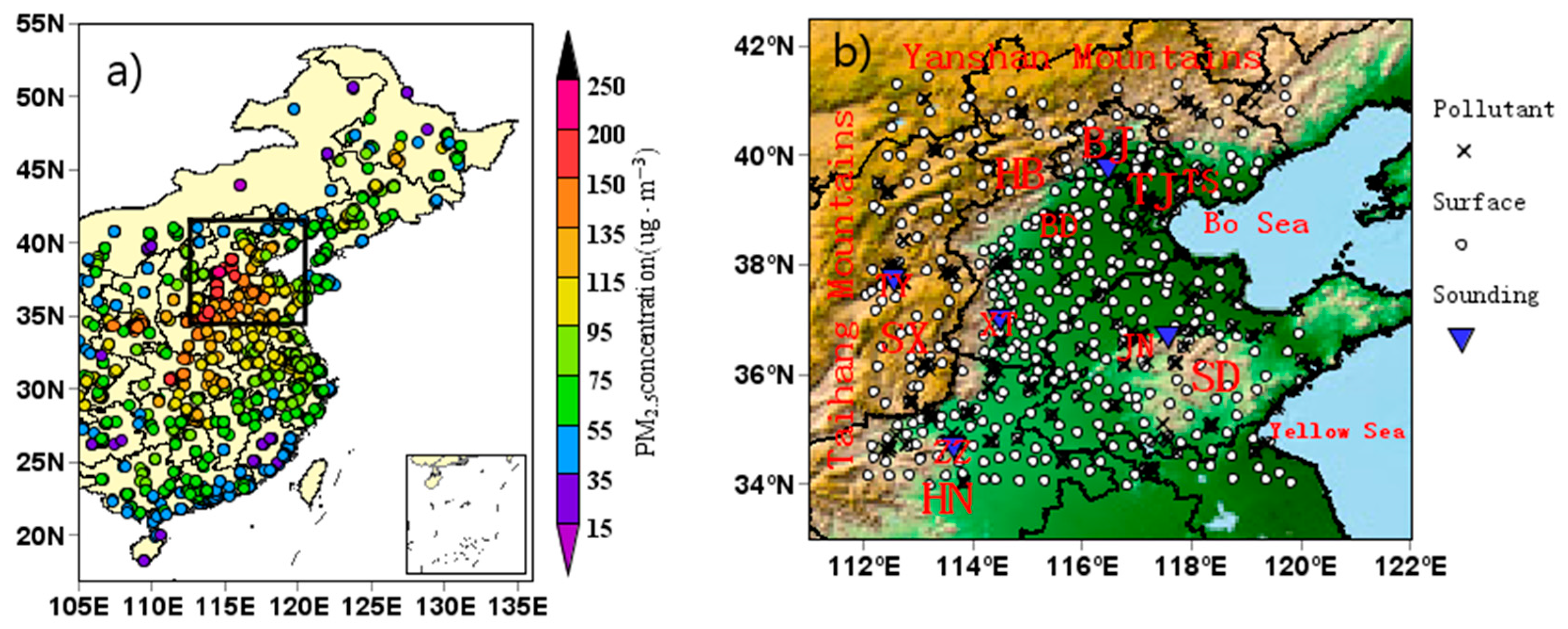
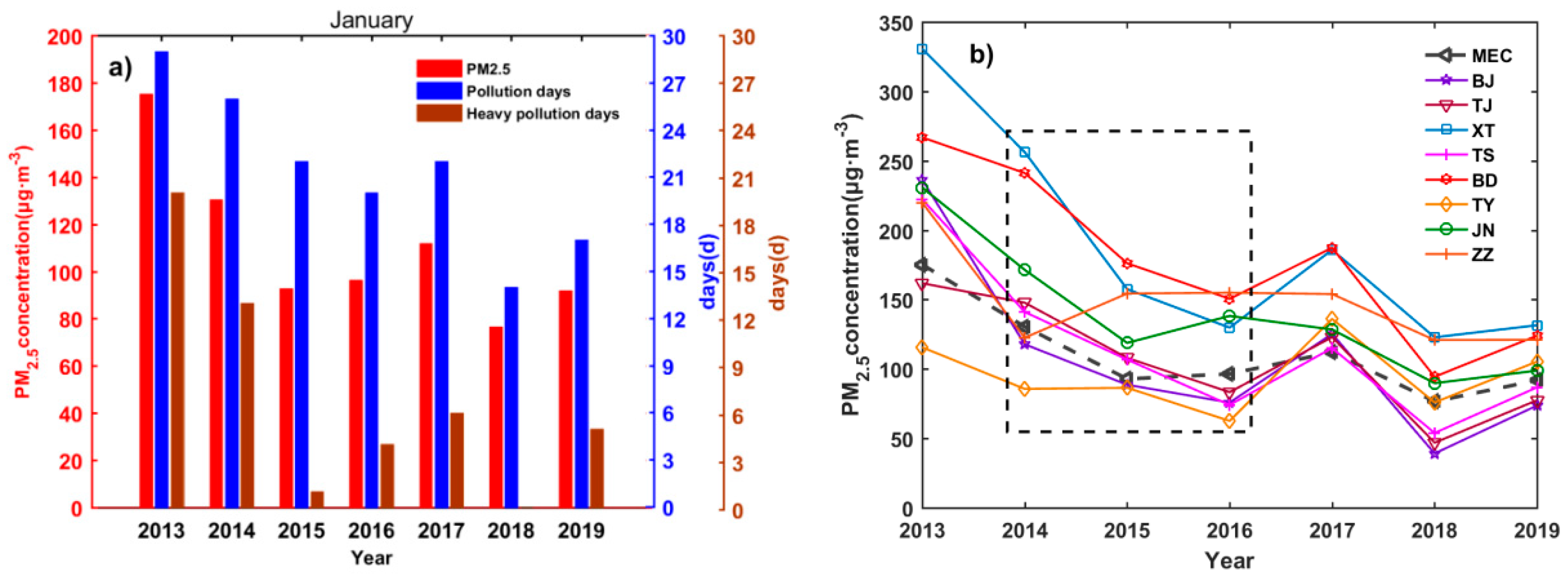
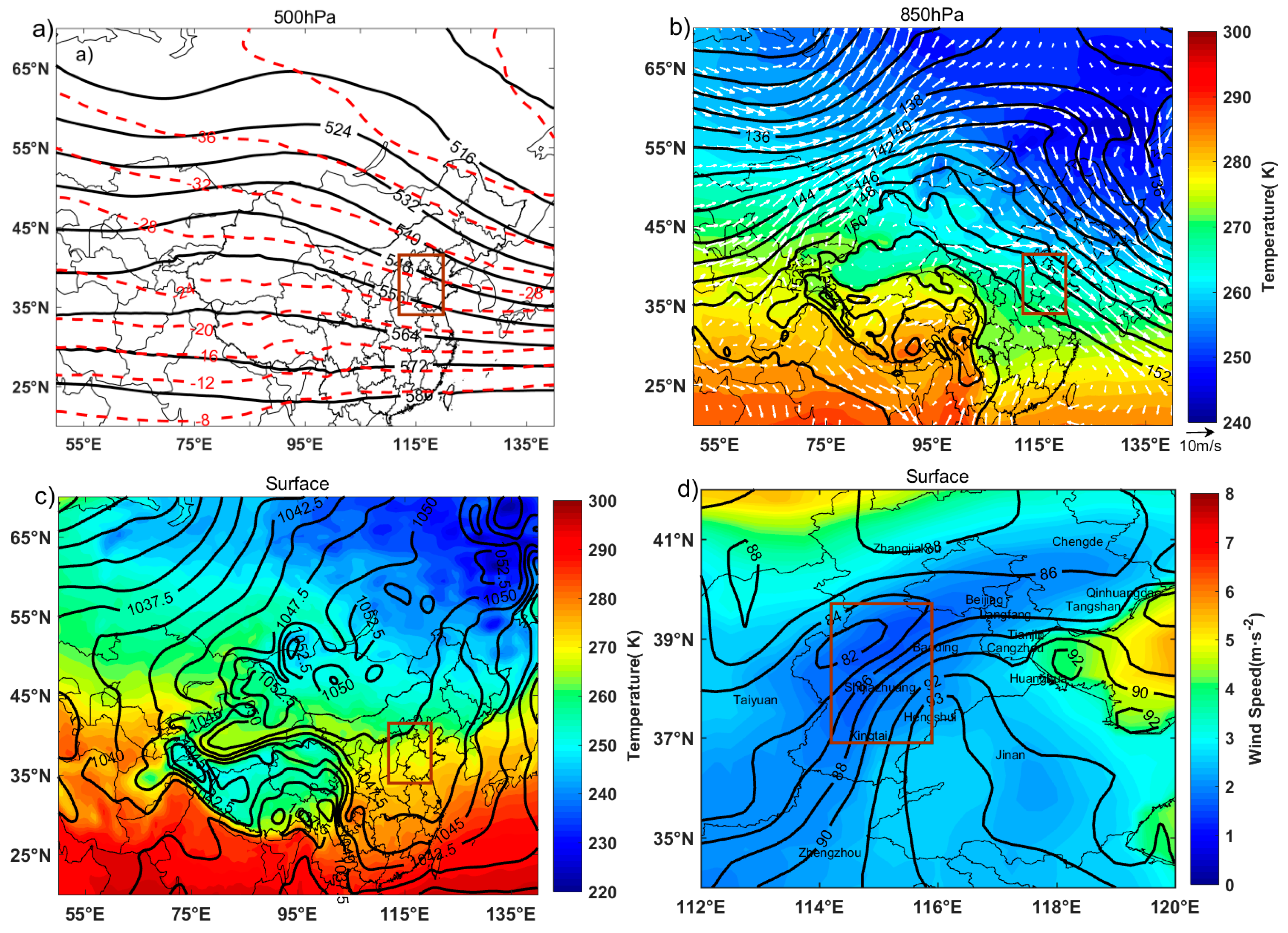
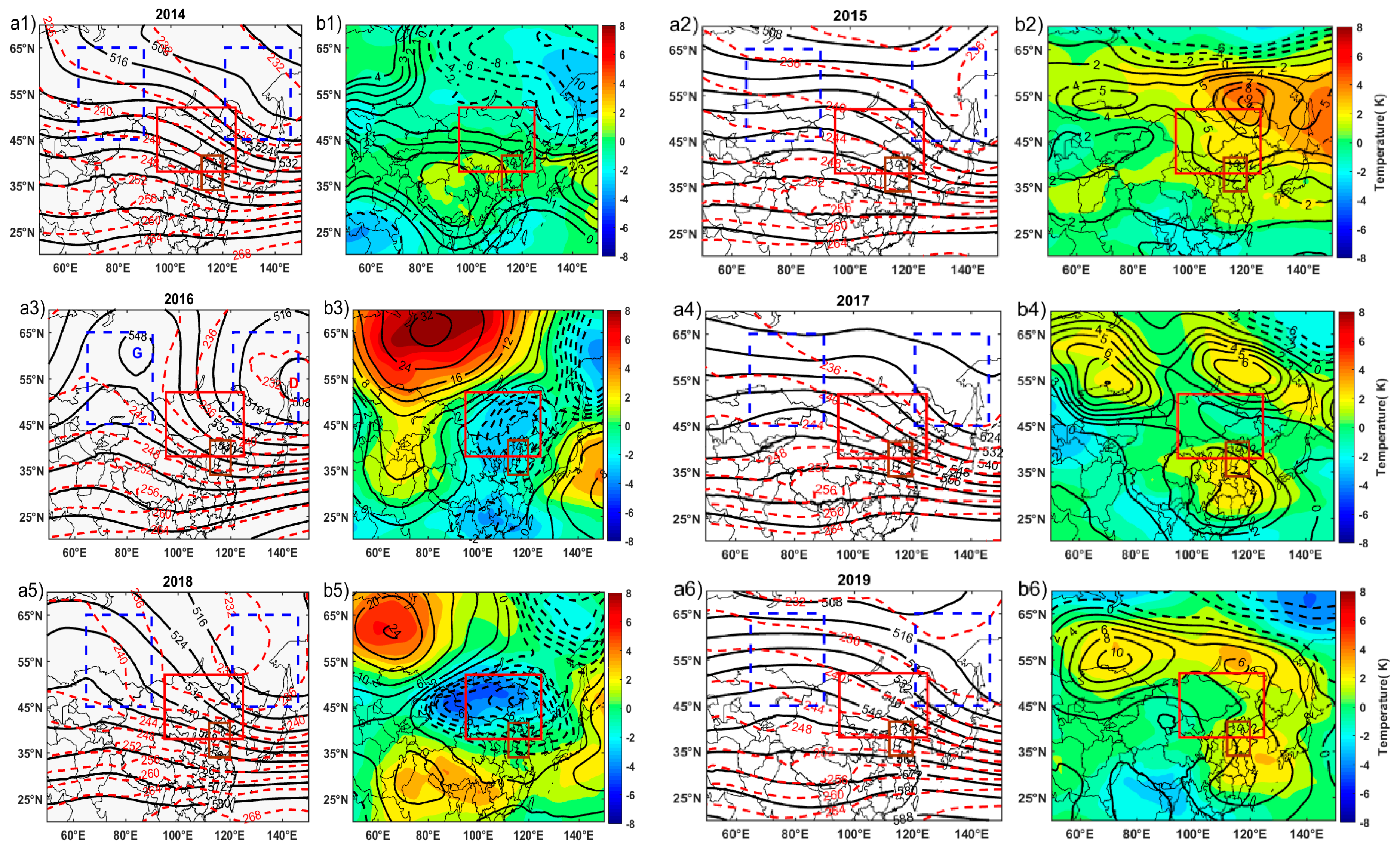
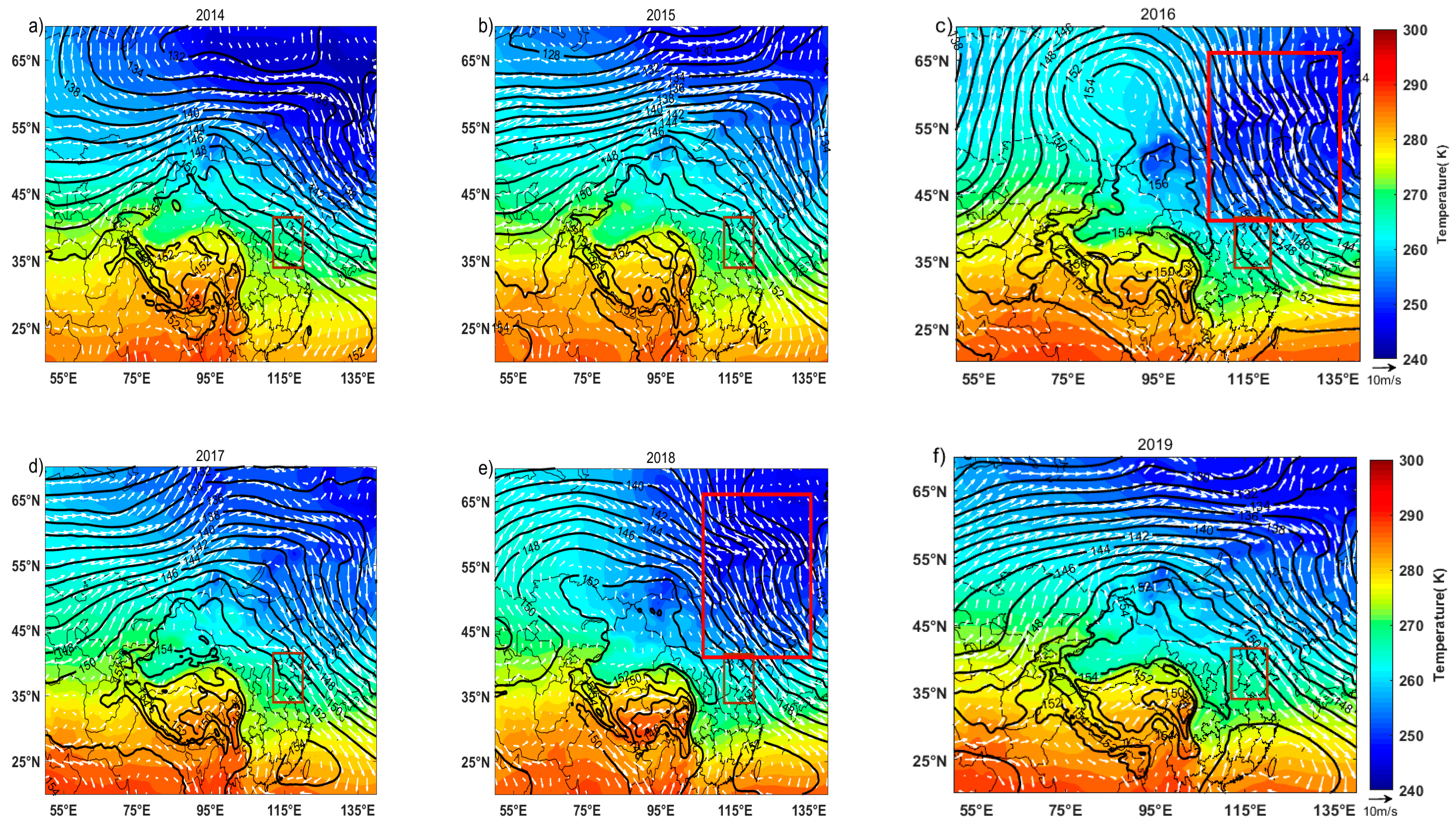
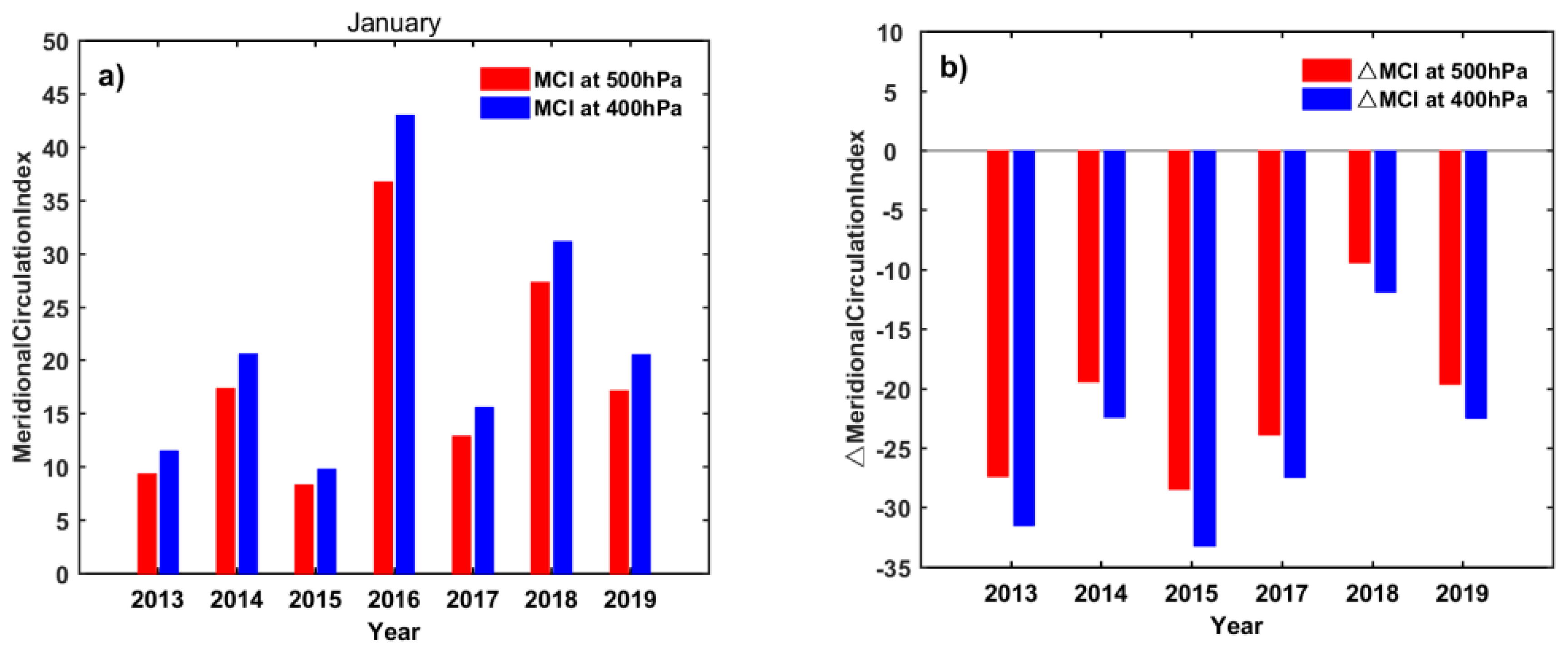
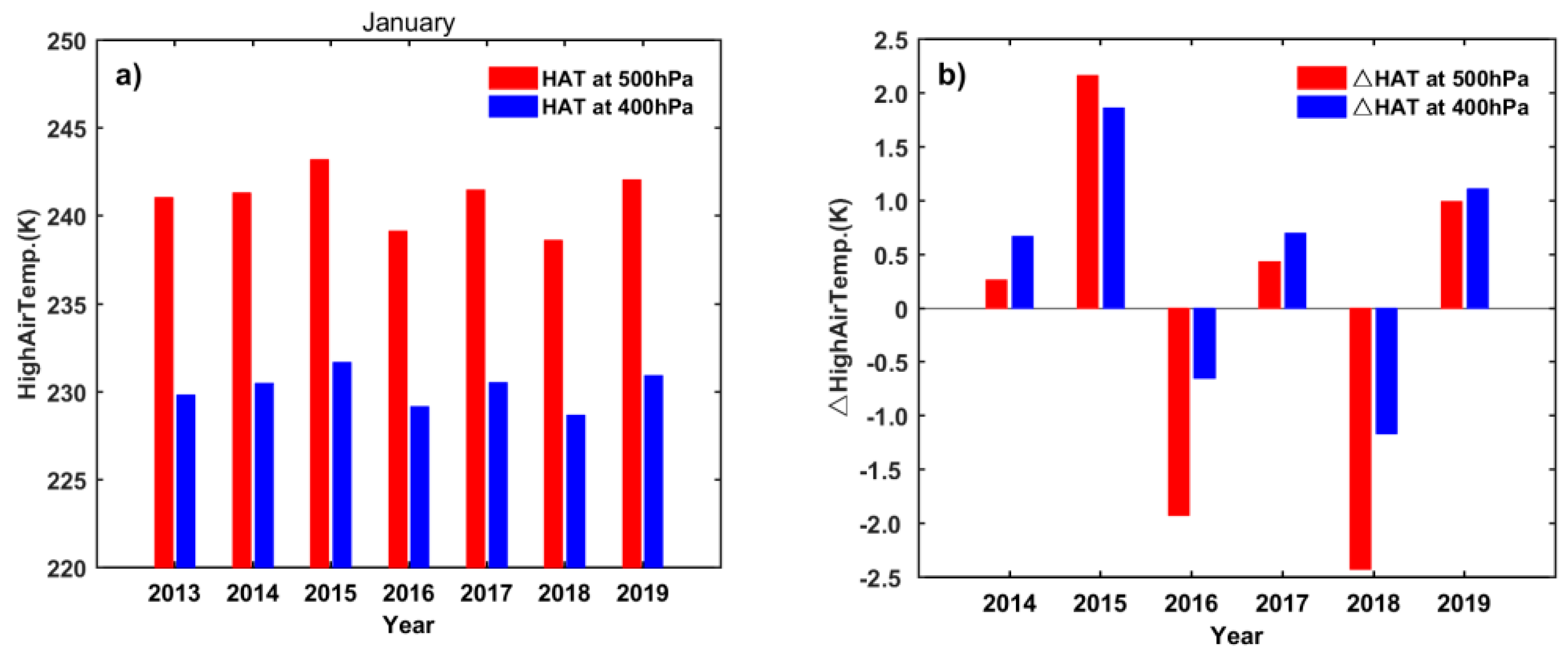
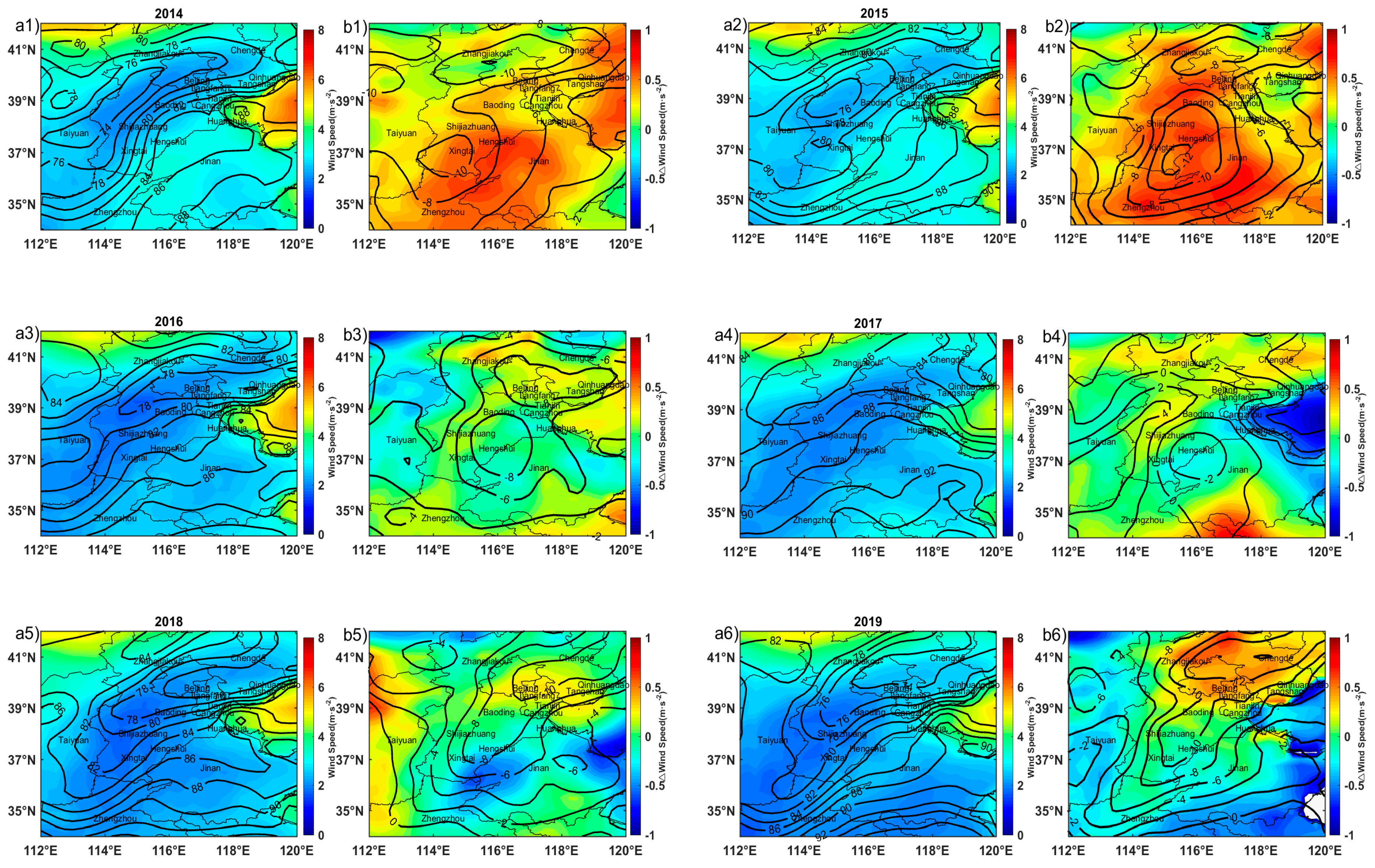
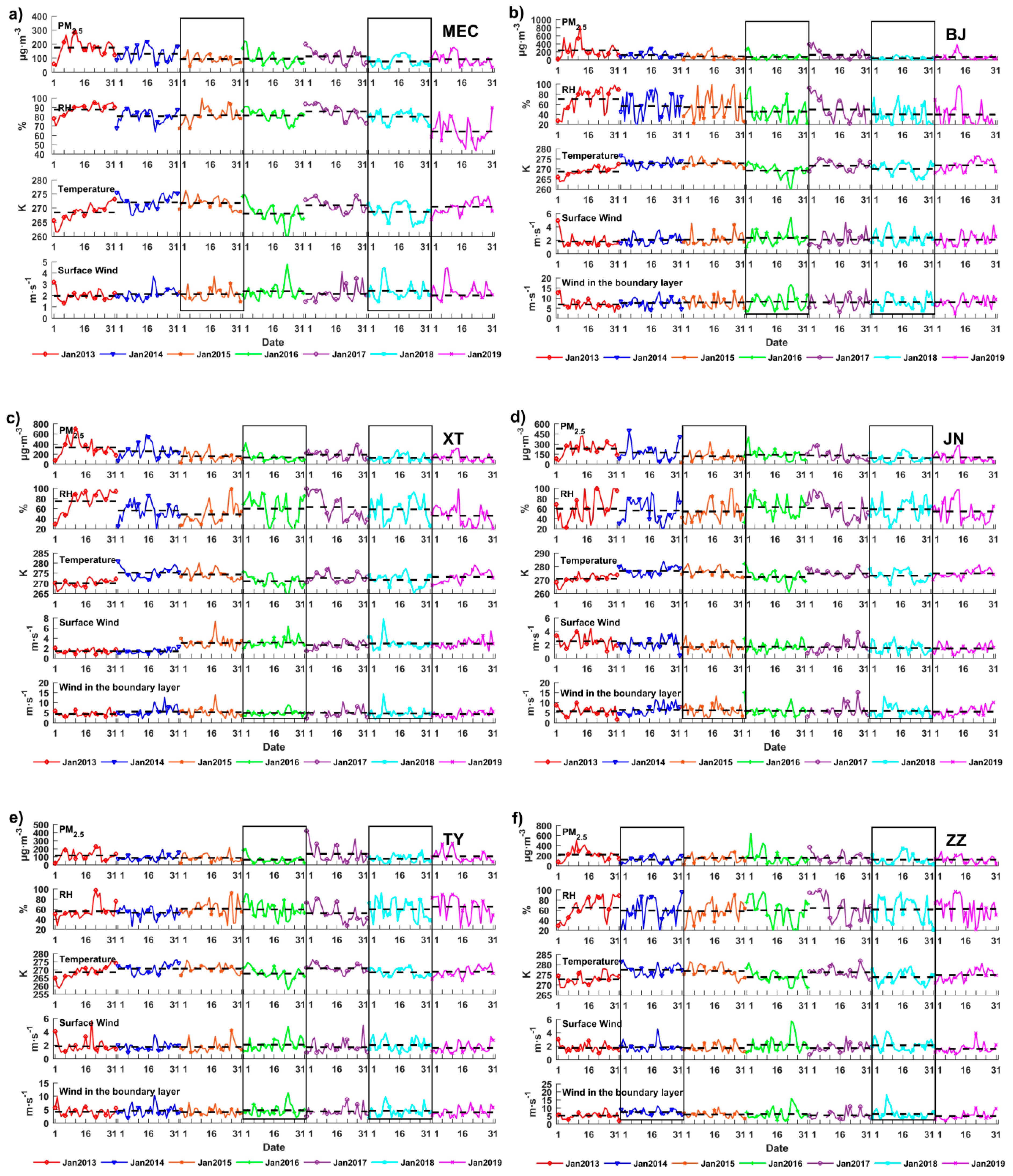
| Air Quality Grade | Average Concentration of 24 h PM2.5 (μg·m−3) |
|---|---|
| Excellent | 0–35 |
| Good | 35–75 |
| Light pollution | 75–115 |
| Moderate pollution | 115–150 |
| Heavy pollution | 150–250 |
| Hazardous pollution | >250 |
| Year | PM2.5 (μg·m−3) | Air Pollution Days | MCI | High-Level Air Temp. | Wind at 700 hPa (m·s−1) | Wind at 850 hPa (m·s−1) | Surface Wind (m·s−1) | Surface RH (%) |
|---|---|---|---|---|---|---|---|---|
| 2013 | 175.2 (100%) | 29 (100%) | 9.3 (−75%) | 241.1 | 10.8 (−10%) | 4.9 (−23%) | 2.0 (−20%) | 87.7 (100%) |
| 2014 | 130.5 (−26%) | 26 (−10%) | 17.4 (−53%) | 241.3 | 11.3 (−6%) | 4.9 (−13%) | 2.1 (−13%) | 80.5 (−8%) |
| 2015 | 92.8 (−47%) | 22 (−24%) | 8.3 (−77%) | 243.2 | 9.5 (−21%) | 4.6 (−18%) | 2.1 (−13%) | 81.7 (−7%) |
| 2016 | 96.5 (−45%) | 20 (−31%) | 36.8 (100%) | 239.1 | 12.0 (100%) | 5.6 (100%) | 2.4 (100%) | 81.4 (−7%) |
| 2017 | 112.0 (−36%) | 22 (−24%) | 12.9 (−65%) | 241.5 | 11.1 (−8%) | 4.6 (−18%) | 2.1 (−13%) | 85.6 (+2%) |
| 2018 | 76.6 (−56%) | 14 (−52%) | 27.3 (−26%) | 238.6 | 11.7 (−3%) | 5.2 (−7%) | 2.4 (100%) | 80.0 (−9%) |
| 2019 | 91.9 (−48%) | 17 (−41%) | 17.1 (−54%) | 242.0 | 8.8 (−27%) | 4.1 (−27%) | 2.0 (−20%) | 78.2 (−11%) |
© 2019 by the authors. Licensee MDPI, Basel, Switzerland. This article is an open access article distributed under the terms and conditions of the Creative Commons Attribution (CC BY) license (http://creativecommons.org/licenses/by/4.0/).
Share and Cite
Liu, Z.; Wang, H.; Shen, X.; Peng, Y.; Shi, Y.; Che, H.; Wang, G. Contribution of Meteorological Conditions to the Variation in Winter PM2.5 Concentrations from 2013 to 2019 in Middle-Eastern China. Atmosphere 2019, 10, 563. https://doi.org/10.3390/atmos10100563
Liu Z, Wang H, Shen X, Peng Y, Shi Y, Che H, Wang G. Contribution of Meteorological Conditions to the Variation in Winter PM2.5 Concentrations from 2013 to 2019 in Middle-Eastern China. Atmosphere. 2019; 10(10):563. https://doi.org/10.3390/atmos10100563
Chicago/Turabian StyleLiu, Zhaodong, Hong Wang, Xinyong Shen, Yue Peng, Yishe Shi, Huizheng Che, and Guanghui Wang. 2019. "Contribution of Meteorological Conditions to the Variation in Winter PM2.5 Concentrations from 2013 to 2019 in Middle-Eastern China" Atmosphere 10, no. 10: 563. https://doi.org/10.3390/atmos10100563
APA StyleLiu, Z., Wang, H., Shen, X., Peng, Y., Shi, Y., Che, H., & Wang, G. (2019). Contribution of Meteorological Conditions to the Variation in Winter PM2.5 Concentrations from 2013 to 2019 in Middle-Eastern China. Atmosphere, 10(10), 563. https://doi.org/10.3390/atmos10100563





